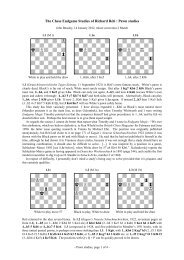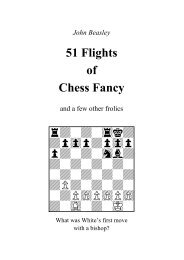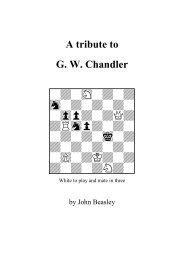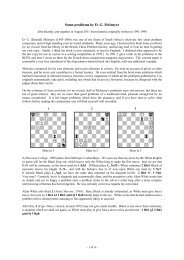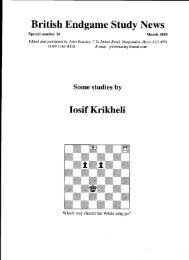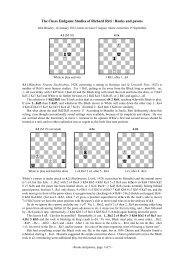THE THEORY OF CHESS PROBLEMS - John and Sue Beasley
THE THEORY OF CHESS PROBLEMS - John and Sue Beasley
THE THEORY OF CHESS PROBLEMS - John and Sue Beasley
- No tags were found...
Create successful ePaper yourself
Turn your PDF publications into a flip-book with our unique Google optimized e-Paper software.
3. The problem as a puzzleDfficultyTo attach the term problem to a chess composition implies that not the least of its properties is the difliculty ofuncovering its solution. In this respect a problem is like a puzzle, <strong>and</strong> the more diffrcult this puzzle is to solve <strong>and</strong>the more obscure the combinations that it embodies, the more perfect it will appear from this point of view.Difiiculty of solution is therefore commonly regarded as an important criterion in the judgement of a problem.However, often it is given all too much emphasis; many composers regard it as the most important or even theonly criterion, <strong>and</strong> other artistic considerations are undervalued or wholly ignored.This extreme st<strong>and</strong>point cannot be endorsed. It downgrades the character of something which is primarily anartistic creation, <strong>and</strong> whose puzzle aspect is only a part of its nature. In the true sense of the word, a problem isnever a mere riddle. Put yourself in the position of the solver, <strong>and</strong> ask how much pleasure it gives him to unravela position whose solution is deeply obscure but otherwise without interest or merit. The answer is no pleasure atall; rather, the waste of time provokes resentment. Can difliculty be regarded as an inherently good quality evenin such a case?We therefore count difliculty as a desirable quality only when the solution that unfolds is worthy of it.A problem in which this principle is ignored may be an exceedingly dem<strong>and</strong>ing chess riddle, but it is not a trueproduct of the problem art. For this reason it is ridiculous to try <strong>and</strong> increase the importance of obscurity to thedetriment of other artistic qualities. It often happens that a position is deliberately <strong>and</strong> unnecessarilycomplicated, where the multiplicity of material obscures the clear outlines of the position, <strong>and</strong> where the solverneeds a certain time to unravel what is going on. In other cases, a problem is deformed by the presence of a piecewhich plays no role in the solution <strong>and</strong> eists only to try <strong>and</strong> lure the solver down false paths.Two-movers, in particular, tempt even problemists of strict principle to such violations of the artistic nature ofthe problem. To inject artificial <strong>and</strong> unnatural diffrculty in this way is of course wholly despicable. True diflicultyflows from the nature of the solution itself; it is a natural consequence of true artistic work.Constructional aspects are another source of difficulty, <strong>and</strong> it is the composer's duty to eliminate the slightestclue from the original position. This applies particularly to partially prepared mating positions, indicated inparticular by groups of Black men or by White pawns, <strong>and</strong> unnaturally or awkwardly placed men. TIrc originality ofthe play also has an important influence. It is much easier for a solver to find a familiar line of play than onewhich is striking or original; in particular, a hackneyed sacrifice often puts the solver on the right track, even ifitonly occurs in a subsidiary variation.Suitably placed White men, having a wide range of attacking options, contribute significantly to theconcealment of the solution, especially when some of the resulting lines of play appear to have the artisticqualities that we expect of the solution itself. These delusive lines are called tries. In two-movers <strong>and</strong> threemovers,in particular, they help the composer to increase the difficulty of his work.The composer is also well advised not to give Black the possibility of a strong counter-attack. The reply tosuch an attack is usually easy to see, <strong>and</strong> this puts the solver on the track of the complete solution.The prolferation of variations adds to the diffrculty of a problem. The solver requires more time if he wants totie up all the loose ends. That said, of course some of the more obvious lines, if they are important, often put thesolver on the right track. And the nature of the individual moves of the solution is very important. It is much easierfor the solver to find checking sequences than unexpected quiet moves. The nature of the key is especiallyimportant.Depth ofconstruction, delicate threats, <strong>and</strong> concealed defensive moves prevent the solver from quickly unravellingthe complete solution even when he has uncovered the main idea.Of course, difficulty of solution is a subjective matter, <strong>and</strong> depends on many different factors. To lat downspecial instructions for solution would be wholly superfluous. The solver should seek guidance in all these aspectsby which the difiiculty of solution is exaggerated.12-



